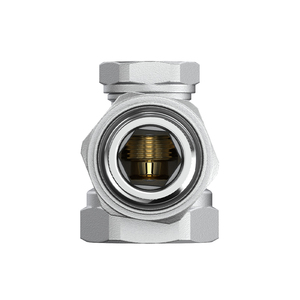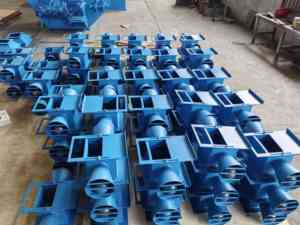
All categories
Featured selections
Trade Assurance
Buyer Central
Help Center
Get the app
Become a supplier

(1049 products available)




























Rotary valve types are determined by the operating mechanism, sealing arrangements, and design features that help in the efficient handling of bulk cement materials in the rotating valve applications.
These valves are operated using pneumatic pressure for opening and closing the valve. In cement industry, pneumatic rotary valves are used for helping in the control of cement flow under given pressure and temperature conditions. Also, these valves are durable and require very little maintenance., hence are very suitable in the demanding cement industry.
These valves do not have any kind of automation and need manual intervention for operating the valve. In the cement plant, the manual rotary valve is used mostly in those processes where the automation is not possible. For example, in small systems valve for cement powder to pass through, these valves will allow little control for flow.
These valves have an electric actuator. The electric actuated rotary valves are used to automate the flow control process of the cement in the manufacturing plant, these valves are also used where pneumatic systems may not be feasible. The electric actuators provide precise control over the valve and thus ensure consistency in the flow of cement.
These valves are designed to handle abrasives like ordinary portland cement and coal vertical mill. The cement industry includes rotary valves which can withstand wear brought on by abrasive substances. Heavy-duty valves usually possess reinforced housings and stronger rotors for the handling of such tough conditions in the cement industry.
Double seal rotary valves have two seal arrangements, which ensure better sealing of the valve. This is generally used in those applications where very high or very low temperature or pressure will be seen. In the cement industry, these valves assist in maintaining the correct flow of material without affecting environmental conditions inside the valve.
In side entry rotary valves, the drive mechanism is located on one side of the valve. The side entry rotary valves are ideal for the space constrained applications in the cement industry. The drive mechanism takes up less space compared to other valve designs.
Rotary valve features include the valve design, material of construction, sealing mechanism, and the application it is best suited for.
Pneumatic rotary valves, manual rotary valves, electric rotary valves, and heavy-duty rotary valves, ensure there is no leakage of the material. Heavy duty rotary cement valves have superior sealing properties due to reinforced seals and valve body designs. Therefore, they prevent escape of cement particles and entry of contaminants into the system.
Rotary valves used in cement industries are manufactured from strong and abrasion resistant materiales such as cast iron, carbon steel and stainless steel. These materials offer strength and durability to the rotary valve structure, withstand the mechanical stresses and abrasiveness of cement particles, and enhance the service life of the valves.
Rotary valves employed in the cement industry are designed to bear a vast range of temperatures and pressures. This is due to the extreme operational environment. The housing and internal elements are distinguished by their robust design and powerful materials, which confer the ability to withstand the cement industry parameters.
Rotary valves enable control of the material flow in the cement processing lines. The electric and pneumatic rotary valves have high accuracy in flow regulation, while the manual rotary valves provide flexibility in flow direction. In general, the valves help to keep the cement manufacturing processes such as blending, milling, and curing within specified rates of flow.
Cement contains particle abrasiveness, thus requiring rotary valve materials with great resistance to wear and or abrasion. Moreover, cement exposure may lead to corrosion. Therefore, in the cement plant, rotary valves are often coated with an anti-wear coating or made of corrosion resistant materials. This helps in increasing their longevity and reliability.
The design of cement industry rotary valves is generally meant for easy maintenance, often involving easily removable components. This will result in a minimum system downtime for the maintenance of the valves. In addition, certain valves are fitted with self-cleaning mechanisms that reduce manual cleaning operations.
The flow rate requirements are measured in cubic foot per hour. That is the volume of material the rotary valve must pass within a specified period. Cement silos with high flow rates require large valve sizes and robust designs for handling bulk materials. On the other hand, low flow rate applications will need smaller valve sizes, since less amount of material will pass through.
The operating pressure and temperature determine the type of materials to use in the valve construction. At high pressures and temperatures, use strong seal materials such as PTFE and elastomeric compounds like nitrile rubber. The seals and valve body in the rotary valve should be designed to withstand the given operating pressures and temperatures.
In applications where high precision is needed in the flow control, prefer electric rotary valves. In cement applications where the flow control is less critical, manual rotary valves can be used. In case the flow control is frequent, go for pneumatic actuators because they are easy to operate.
They include particle size distribution, moisture content, and chemical composition. The size of the rotary valve should at least accommodate the largest particle size occurring in the cement. Moisture will cause some cement to cake, and this will require valves with efficient cleaning mechanisms.
In the cement industry, the rotary valves should always be made of wear resistant material such as carbon steel, cast iron, or stainless steel. Equally, the internal sealing elements should be made from materials like PTFE and nitrile rubber, which provide corrosion resistance.
Maintenance requirements should be considered when selecting a rotary valve. In the cement application services should have easy maintenance procedures, such as disassembling and cleaning the valve. Also, some models have self-cleaning mechanisms and wear indicators that help in reducing the maintenance interval.
A1. The selection of the rotary valve will affect the flow rate and accuracy of material handling within the system. Improperly sized rotary valves will lead to either over or under blending of materials. Undermixing will cause inertial segregation of particles, while overmixing will lead to particle degradation.
A2. Some of the failing signs include the presence of cement dust outside the valve, which indicates poor sealing; high variability in the flow rate, leading to process upsets; strange noises or vibrations which could signal mechanical wear and tear; and frequent overlapping of spikes in the maintenance requirements with a consequent reduction in system performance will also indicate the need to replace the valve.
A3. Yes. Rotary valves are often used to work with pneumatic conveyors, metering devices, and bagging machines. For example, rotary valves can be used to regulate flow between two pieces of equipment, thus improving the overall operational efficiency and process integration.
A4.The frequency of inspection is largely dependent on the application and how heavy the duty is. Some must be inspected more frequently for wear and tear, whereas others can go weeks without being looked at. In addition, continuous operation standard practice recommends inspecting the valves used in the cement industry at least once a month.
A5.Pneumatic rotary valves act as the metering device in pneumatic conveying systems. The valves help in the precise flow of material between processes while maintaining system pressure differentials. Also, the valves ensure that the material is transported without segregation or degradation.